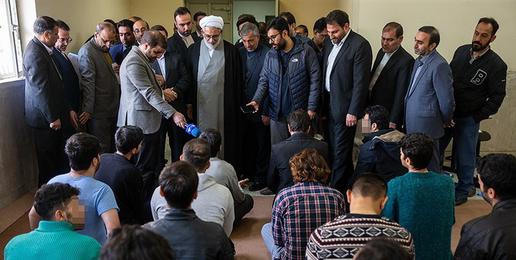IranWire has learned that people arrested and detained following the recent nationwide protests have been tortured, subjected to interrogations and are being held in substandard and crowded conditions. There have also been claims of sexual violence and rape at the Tehran prison, where more than 1000 people are said to be detained.
Sources from within Fashafuyeh Prison, as well as one person who was recently released, say that prisoners have been physically assaulted during interrogations, and in some cases have sustained broken bones.
Shortly after being released on November 25, a former inmate said he thought about 1200 people were being held in the prison, and confirmed that many were being tortured. He said students held in the prison were being treated marginally better, but most detainees were being subjected to harsh beatings.
“Revolutionary Guards’ intelligence agents interrogate the detainees, resorting to tactics of brutal torture and beating of prisoners,” one source said. “The hands and legs of some of the detainees have been broken during interrogations in a very strange way.” He said prison authorities had transferred prisoners to several outpatient clinics and treatment centers by ambulance to deal with the injuries.
It is unclear whether the detainees’ bones were broken accidentally while agents handled inmates during interrogations, or whether agents have deliberately been injuring them in this way as a tactic of intimidation and to instil fear among other prisoners.
The reports about Fashafuyeh, which is also known as Greater Tehran Prison, have triggered alarm in Iran because descriptions of the prison closely resemble those of conditions at the former Kahrizak Detention Center, where hundreds of protesters were incarcerated in 2009 following widespread protests, and where three people died. Iranians have expressed fears that the same situation could be repeated at Fashafuyeh.
Tehran Official Confirms Reports of Dire Conditions
On November 25, the head of Rey District Council warned that the prison was at capacity. “Following the protests last week, the number of detainees in Fashafuyeh Prison has increased, and the prison can no longer respond to this volume of detainees," Hassan Khalilabadi said.
Speaking to the Iranian Labor News Agency (ILNA), Khalilabadi said, ”Fashafuyeh Prison does not have the necessary facilities and it is difficult to accommodate such a large number of detainees. I urge all authorities, especially the judiciary, to take note of the current situation in the prison."
Khalilabadi said prison staff was struggling to maintain basic acceptable conditions for the prisoners. “We hope that the Prisons' Organization, the Ministry of Justice, the judiciary, and the state and provincial officials will help to improve the conditions in the prison," he said.
But Mizan News Agency, which is linked to the judiciary, denied claims that conditions in the prison were substandard. It reported that the prosecutor general, Mohammad Jafar Montazeri, had visited Fashafuyeh on Saturday, November 23 for two hours and spoke to some of the detainees who had been arrested during recent protests. "All those arrested in the events that followed the gas rationing are satisfied with their prison conditions,” he told the agency.
According to one source who spoke to IranWire, Revolutionary Guards Intelligence agents have set up two Conex shipping containers outside the Guards’ Intelligence Department, where the detainees are being interrogated.
People arrested during the protests over the hike in gas prices are being held in a new section of the prison that is “not yet equipped with the minimum facilities and is in fact not ready to operate,” a source inside the prison said, adding that the prison could not cope with the 1,000 or more people currently detained there, as Khalilabadi had confirmed.
Protesters Held with Dangerous Criminals
Fashafuyeh Prison was originally built for drug offenders, but in recent years political prisoners and prisoners held on security-related charges, including a number of Gonabadi dervishes, have been transferred to the prison.
"The judiciary should have complete supervision over the conditions of detention in prisons, as dangerous inmates are also detained in the custody of the judiciary,” Hassan Khalilabadi said in his interview with ILNA. “The responsibility is heavy,” he added, urging officials to take the issue seriously.
Seyyed Heshmatollah, the director of Tehran's prisons, criticized Khalilabadi for the remarks, dismissing claims that Fashafuyeh Prison was dangerous. He said facilities were up to standard and safe, and “the authorities have seen it."
But Hayat al-Ghaib’s claims that prisoners are safe contrasts sharply with recent news about the prison. In June 2019, Alireza Shirmohammad Ali, a 21-year-old man jailed at Fashafuyeh for political reasons, was killed by two inmates armed with handmade knives. A few months before his murder, he had demanded to be transferred from this prison so he could be kept in a ward with political prisoners.
Iran’s Gonabadi dervishes, who have been targeted and arrested by authorities and taken to the prison over the last two years, have also repeatedly reported on the deterioration of conditions in the prison, and about their treatment while there. They have been repeatedly subjected to violations of their human rights, including their right to be kept in separate wards from dangerous criminals.
Prior to the recent reports, Mohammad Sharifi Moqaddam a dervish prisoner at Fashafuyeh, published his account of prison conditions [Persian link]. He described shocking details of drug addiction, drug trafficking, and sexual violence in the prison.
With news about the recent torture and harsh treatment of protesters and warnings from Tehran councilor Hassan Khalilabadi, the memory of Kahrizak Detention Center – which was also meant to house serious criminals and not people arrested for protests or for destroying public property – has once again been brought to the forefront of people’s minds. In particular, the families of the three men who were killed, Amir Javadifar, Mohammad Kamrani, Mohsen Rouholamini, will be reminded of the injustice that was carried out against civilians demanding their rights be upheld.


























comments